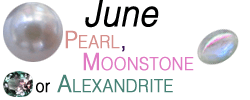|
|
|

Truly ancient, the garnet has been the gem of faith and truth for centuries, bestowing upon the wearer the quality of constancy and the ability to make deep and lasting friendships. Like other red stones, garnet was considered a remedy for hemorrhage and inflammatory disease and a general protection from wounds.
Commonly thought of as a dark red stone, it is actually a large family of gems occurring in every color but blue. Brilliant, colorful and durable, garnets have been found on every continent, but most are mined in Southeast Asia, Brazil and Africa.
|
|

Believed by the ancient Greeks to have been stained with the wine of Bacchus, this stone was thought to be an amulet against intoxication and so named "amethustos" or "not drunken". It can also calm anger, quicken the wit and make one shrewd in business matters.
Amethyst has been prized ever since, particularly by nobility, for its rich purple hues. It may be found in colors ranging from the palest lavenders to the deepest purple. Generally, the deeper the color the more highly prized the stone. A member of the quartz family, amethyst is mined extensively in Brazil and Zambia.
|

Derived from the Latin, no gem has a more descriptive name than the aquamarine. The name aquamarine literally means "seawater", a tribute to its beautiful blue color. Long associated with tranquility and happiness, aquamarine was also thought to instill courage, cure laziness and sharpen the intellect.
Like emerald, aquamarine is a member of the beryl family. It is frequently free of flaws and may occur in very large crystals. The aquamarine is not a brilliant stone, but depends on its size and purity of color for effect. Brazil is the most prolific supplier of aquamarine, which is often found in shades of blue-green.
|
|

The diamond has been a symbol of eternal love since the 15th century, when Archduke Maximillian of Austria sealed his engagement to Mary of Burgundy with a diamond ring. Of all jewels, the diamond is supreme and worthy of the name precious stone. It qualifies for all the virtues implied in that term: brilliance, hardness, rarity, antiquity, purity and permanence.
Although the most desirable diamond is colorless, distinct body colors such as blue, green, red, pink, and yellow are known. These natural fancy colors are rare and highly prized.
While India was the world's main source of diamonds for over 2,000 years, most diamonds now come from Africa, Russia and Australia. Of all diamonds mined, only a quarter are of gem quality.
|

One of the most valuable gems, emerald has been coveted through history. It was attributed such great power that it was often used in powdered form to prevent epilepsy, stop bleeding, cure dysentery and fever, and avert panic. In addition, emerald was thought to make its owner eloquent and persuasive, bring joy, give the ability to foretell the future and improve memory.
The choicest member of the beryl family, the ideal shade for emerald is an intense green, distinct from any other green gemstone. Larger size stones tend to contain slight faults or flaws. Accordingly, good sized perfect stones are extremely rare, which accounts for their costliness. Colombia and Africa are the major sources for emerald.
|
|

Since the Hindu god Vishnu searched the seas for a pearl to adorn his daughter on her wedding day, pearls have been the symbols of love, happiness, wealth, honor and longevity.
Both natural and cultured pearls form when a piece of sand, shell or other irritant causes the oyster to coat the foreign body with the pearly substance known as nacre. The value of a pearl is determined by several factors: the perfection of its shape, size, color and freedom from blemishes.
Today, Japan is a major source for cultured pearls.
|

Many times rarer than diamonds, rubies have been passionately admired throughout the world, throughout history. The powers that have been ascribed to ruby over the centuries are innumerable. Even the Bible compares the price of wisdom to the price or rubies. Rubies were also said to protect their owners from misfortune and to reconcile disputes.
A member of the corundum family, as is sapphire, the hardness of a ruby is only surpassed by that of a diamond. While the color can range from a pink-red to a purple-red, the most dramatic stones are a bright, intense red.
The world's finest deep red (pigeon blood) rubies come from Burma. Today, the world's major sources of rubies are in Thailand. Thai rubies are mostly dark and brownish-red.
|
|

Although its name is simply a French word derived from the Arabic for green, peridot has always been surrounded by complex superstitions. It was believed to inhibit enchantments, to protect its wearer from evil spirits and to glow in the dark.
Its color ranges from a springtime yellow-green to a warm olive green. Peridot is also distinguished by its soft, velvety appearance. Color is the most important quality for peridots. Hence, the greener the peridot, the higher its value.
Mined on the island of Zebirget in the Red Sea since ancient times, peridot also comes from Burma, although most is found in Arizona and the southwestern United States.
|

Ancient Persians believed the earth rested on a giant sapphire whose reflection gave the sky its color. Considered pure and sacred and to confer peace and wisdom on its owner, sapphire is said to refuse to shine if worn by the wicked. Contemplation of a sapphire was also said to cleanse the soul.
Sapphire is a member of the corundum family. And while red corundum is known as ruby, all other colors are known as sapphire.
Most sapphires are mined in Sri Lanka, Thailand, Burma and Australia.
|
|

It has been written that opal possesses the virtues of all stones as it displays their many colors. Opal is a mysterious gem, thought to be a symbol of hope and jinx. The Arabs believed opal to be a gift from heaven that would fall in the flashes of lightening.
The characteristic feature of the gem opal is play of colors; pure colors can be seen in rapid succession as the gem is moved about. Derived from the Sanskrit "upala" and the Latin "opalus", meaning "precious stone", no two stones are ever alike. Found primarily in Australia as well as Mexico, opals are delicate by nature.
|

Topaz is revered for its color, clarity and hardness. During the Middle Ages topaz was thought drive away sadness, bring wisdom, bestow courage, and even cure insomnia.
A common misconception is that all topaz is yellow. Once the name given to all yellow gems, true golden topaz is labeled "Imperial". "Precious" topaz may be yellow, golden-brown, blue, green, pink or sherry colored. Brazil is the most important source of this stone.
|
|

From Egypt and Persia (Iran) to Tibet and the Americas, turquoise has been treasured for its beauty since prehistoric times. Hindus and Persians believed that one who observed the reflection of the moon on a turquoise was assured good luck, protection from evil and great wealth.
Color is the superlative gem property of turquoise. Turquoise can be green yellow-green, blue-green, pale blue or dark blue. It may or may not include a "matrix" of rock which can form intricate lace-like patterns throughout the stone, adding character, but detracting from value. Found in the southwestern United States and Mexico, the richest blue specimens are from Iran.
|
|
